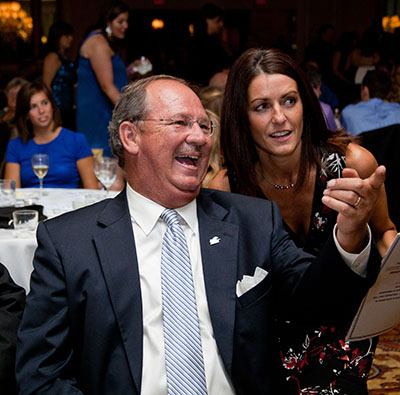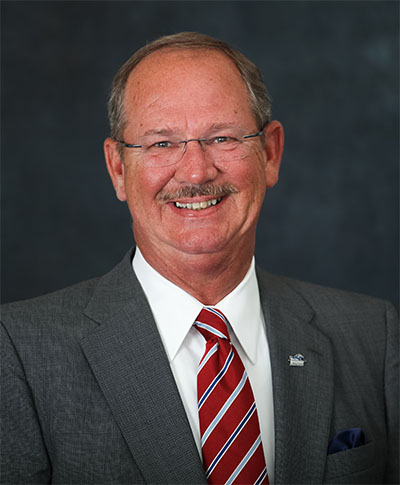For nearly 30 years, Franklin Grant has played a critical role in the progress of Longwood University’s campus and in nurturing its distinctive camaraderie. Serving under seven presidents, he has devoted his career to the university, knitting together its past, present and future.
Grant, Longwood’s senior associate vice president for university advancement, will retire in June, capping a career that President W. Taylor Reveley IV said has left a remarkable imprint on the university.
"Looking around our campus, at new buildings under construction, at our scholarship funds, at our growing student body – none of that momentum would be as strong without Franklin Grant," Reveley said.
But equally important has been Grant’s presence in the Longwood community.
"What sets apart great and proud institutions is often just a handful of people who serve as the lifeblood of a campus," Reveley said. "They know everyone, they exude contagious pride, they connect a place to its history, and they have a tangible effect on its progress.
"For nearly three decades, Franklin Grant has played that role here," Reveley said. "He has been essential in introducing me to so many people and parts of the Longwood family during my first year here."
President Emerita Patricia Cormier, who worked with Grant for 14 years, said Grant’s impact on Longwood had been profound, and been achieved through a mix of patience, charm and passion for the institution.
"One of his greatest attributes is he has the ability to work with people for a long, long time. He has the ability to go the distance, to have infinite patience," Cormier said. He was beloved by older graduates, she said, and knew how to think outside the box—like the time he arranged a "virtual reality" tour for Joan Perry Brock ’64 to help her envision what would later become Brock Commons.
But ultimately, Cormier said, it is Grant’s enthusiasm for Longwood that has most defined him.
"He loves the institution probably as much as he loves anything," she said.
While pushing hard to the finish line, Grant has also been spending time this spring reflecting on the remarkable changes he has witnessed and helped make possible at Longwood.
Yet for all of that, he says, the essentials remain unchanged.
"Obviously we are larger, but it still feels the same," Grant said recently in his Lancaster Hall Office. "The boards and the leadership team through the years have made a conscious effort not to make us look like other public universities."
The upshot: Longwood has grown. But, Grant said, its residential nature, faculty-student ratio and tradition of citizen leadership have kept it distinctive and proud.
"You take grads from ’45 or ’55 or ’95, you hear a common theme," he said. "They went to a school where people knew their name, they were taught by a professor who knew their name." Ensuring Longwood is able to continue being that kind of institution will depend on philanthropy, and that’s his biggest motivator, he said.

Grant first came to Longwood in the late 1970s, after a stint in the Army, during the early days of coeducation. He graduated in 1980, and returned to the university in 1985, working in planned giving and athletics fundraising. He’s held numerous positions, including public address and radio announcing for Longwood basketball and baseball.
But, he said, "I’ve always been a fundraiser. I introduce myself saying, ‘I’m Franklin, I fundraise. If they run off I just find somebody else."
Most stay and listen, and Grant has become a principal contact at the university to generations of graduates who have supported Longwood. His relationships are spread across the Commonwealth and country—and increasingly the world. The donors with whom he’s worked have stretched back to the class of 1915—just shy of a century ahead of the seniors who will graduate this spring.
He has been deeply involved in two capital campaigns, and worked closely with donors who have truly changed the face of campus—among them, Brock; John Cook ’52 and Waverly Cole, who endowed the Cook-Cole College of Arts & Sciences; and Duvahl Ridgway-Hull ’33 and Andrew W. Hull, who endowed millions in scholarships.
Grant also worked closely with Elsie Stossel Upchurch ’43, whose commitments of $4 million on behalf of herself and her late husband Norman helped make possible Longwood’s new student center, and Katharine Allen Maugans ’46, who gave $2.5 million with her husband for the new alumni center, which will be named in their honor.
Each of those relationships has been valuable, but so have countless smaller gifts, especially to support student scholarships. Especially meaningful has been a front-row view of the vast impact Longwood alumni have had as teachers across the Commonwealth, often inspiring students otherwise unconnected to the university to donate on behalf of alumni who taught them.
"For the donor and the recipient, it’s a life-changing thing," Grant said. "The donor’s giving a gift that will pay dividends into infinity. They have to feel good about that." He knows they do; Grant and his wife Nita have given a scholarship themselves.
In recent weeks, Grant has been reaching out to a group of a few hundred alumni with whom he’s worked especially closely, letting them know his plans. What’s next? Grant is eager to get his golf handicap back down to single digits, indulge in a recently discovered passion for camping, and spend more time with his four grandchildren, all sharing the Grant name—Brian Franklin Jr., Elizabeth Michelle, Emma Joyce and Jack Thomas. Beyond that, who knows?
"I set out to retire at this age, and now 62 doesn’t seem as old as I thought," he said.



Leave a Comment